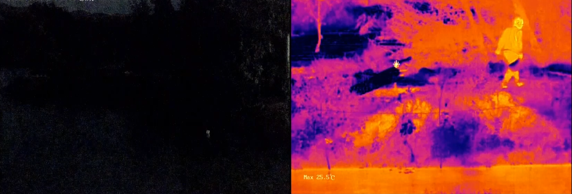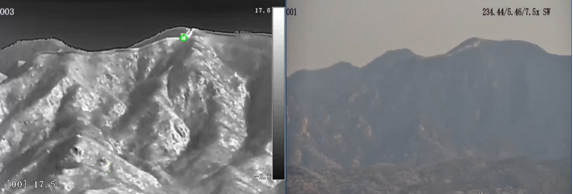Background
The Greenridge National Park, covering over 120,000 hectares of dense forest, had been struggling with seasonal wildfires for years.
These fires caused severe ecological damage, destroyed rare habitats, and posed risks to nearby communities. Traditional fire watch towers and patrols were slow to detect fires, especially at night or in poor weather conditions such as fog, rain, and snow.


Sharp Image without Light Source
The thermal imager forms an image without any visible light with heat radiation from the environment. Long-distance target is detected by it clearly all day
Excellent Cloud-and-Mist Penetration
Infrared thermal radiation has better penetration of rain, snow and haze than visible light, so it can take clear images even in bad weather.


Non-contact Temperature Measurement
Thermal cameras measure accurately the surface temperature of the object by quantifying IR heat radiation without physical contact between sensor and the target.
Faults and Defects Pre-alarms
If there is malfunction occurred on the target, thermal imagers will find it out in a direct way using non-contact and long-distance temperature measurements.
Challenges
- Delayed fire detection – Human patrols often identified fires after they had already spread.
- Poor visibility – Conventional cameras failed in low light and adverse weather.
- Large coverage area – Monitoring thousands of hectares in real time was difficult.
- Integration issues – Existing monitoring systems could not seamlessly share alerts across different platforms.
Solution
Our team deployed the TDD solution Thermal Imaging Wildfire Detection System across key high-risk zones in the park.
Key Features Implemented
- Bi-Spectrum Thermal Cameras
- Thermal: 640×512 resolution with motorized zoom lenses (50mm / 75mm) for ultra-long-range detection (>3 km).
- Optical: 4MP HD for visual verification.
- Works 24/7 without a visible light source.
- All-Weather Performance
- Penetrates fog, rain, and smoke for reliable detection.
- Automatic smart rain-sensing wipers keep lenses clear.
- AI-Powered Fire & Smoke Detection
- Real-time detection of smoke and flame signatures.
- Distinguishes between human activity, vehicles, and environmental heat sources.
- Edge AI + Alarm Integration
- Local AI processing reduces false alarms.
- Built-in high-power speaker and light alarm for on-site deterrence and evacuation alerts.
- Flexible Integration
- Connected to the park’s central control room via SDK and HTTP API.
- Integrated with the emergency dispatch system for instant response.
Results
- Faster Detection – Potential wildfire sources are now detected within seconds of ignition, even at night.
- Reduced Damage – Early alerts allow fire crews to arrive before flames spread, significantly reducing burn area.
- Lower Operational Costs – Reduced reliance on 24/7 human patrols.
- Improved Safety – Protects park staff, visitors, and nearby communities.
- Data-Driven Prevention – Historical detection data helps identify high-risk areas for proactive firebreak planning.
Conclusion
By integrating thermal imaging, AI smoke/flame detection, and long-range bi-spectrum cameras, the Greenridge National Park transformed its wildfire prevention strategy.
The solution now provides continuous, all-weather, 24/7 coverage and has become a model for other forested regions seeking to prevent devastating wildfires.